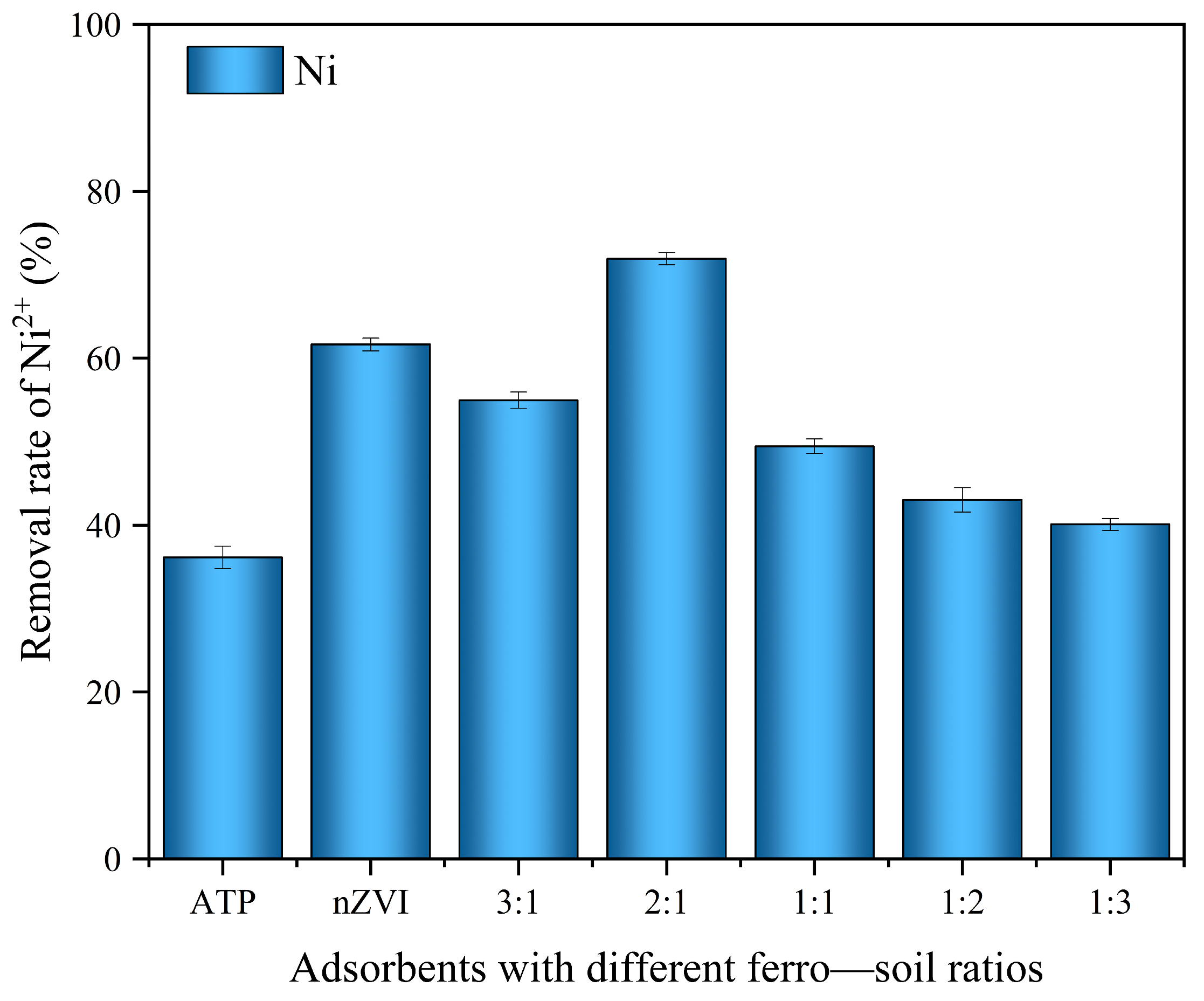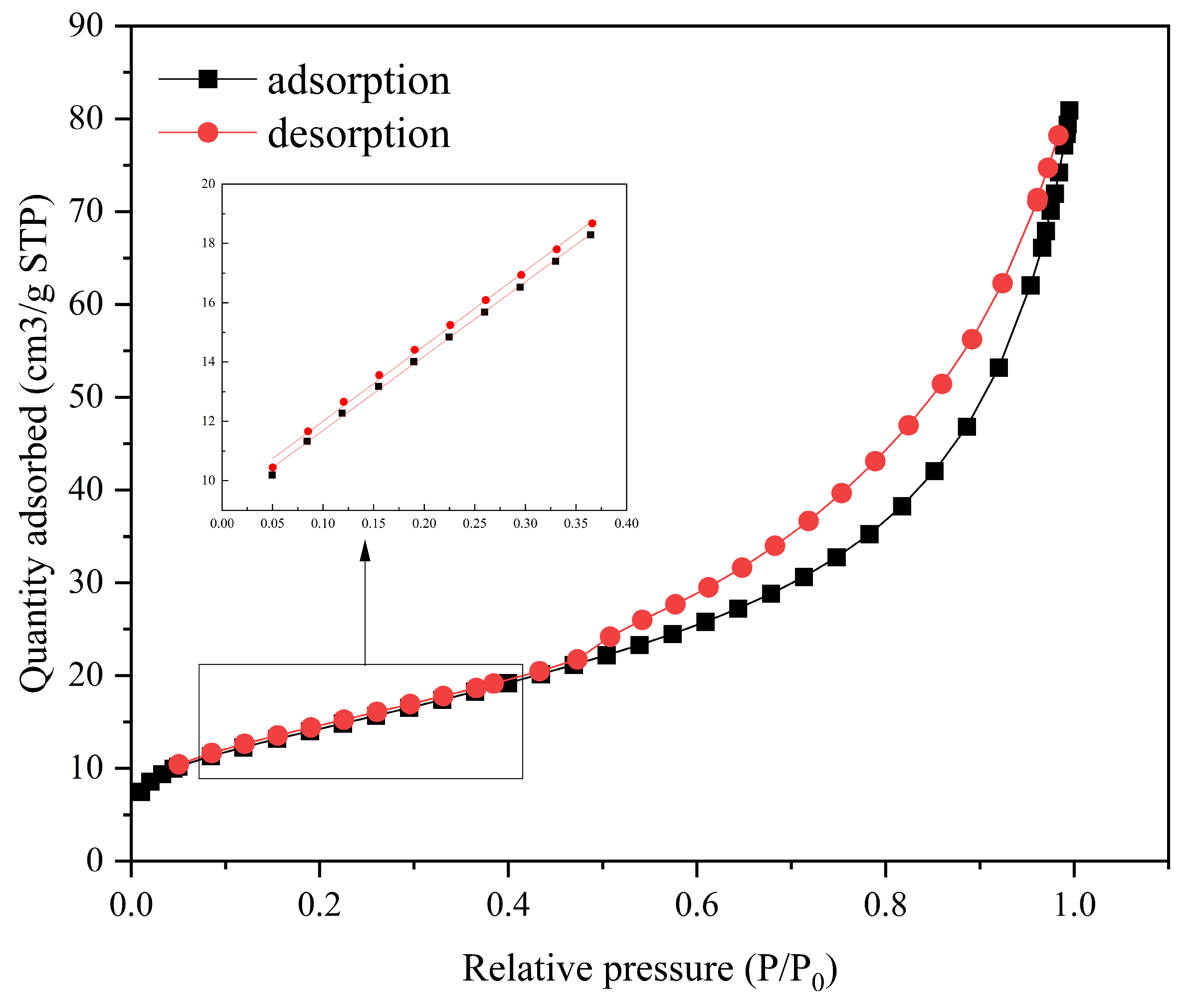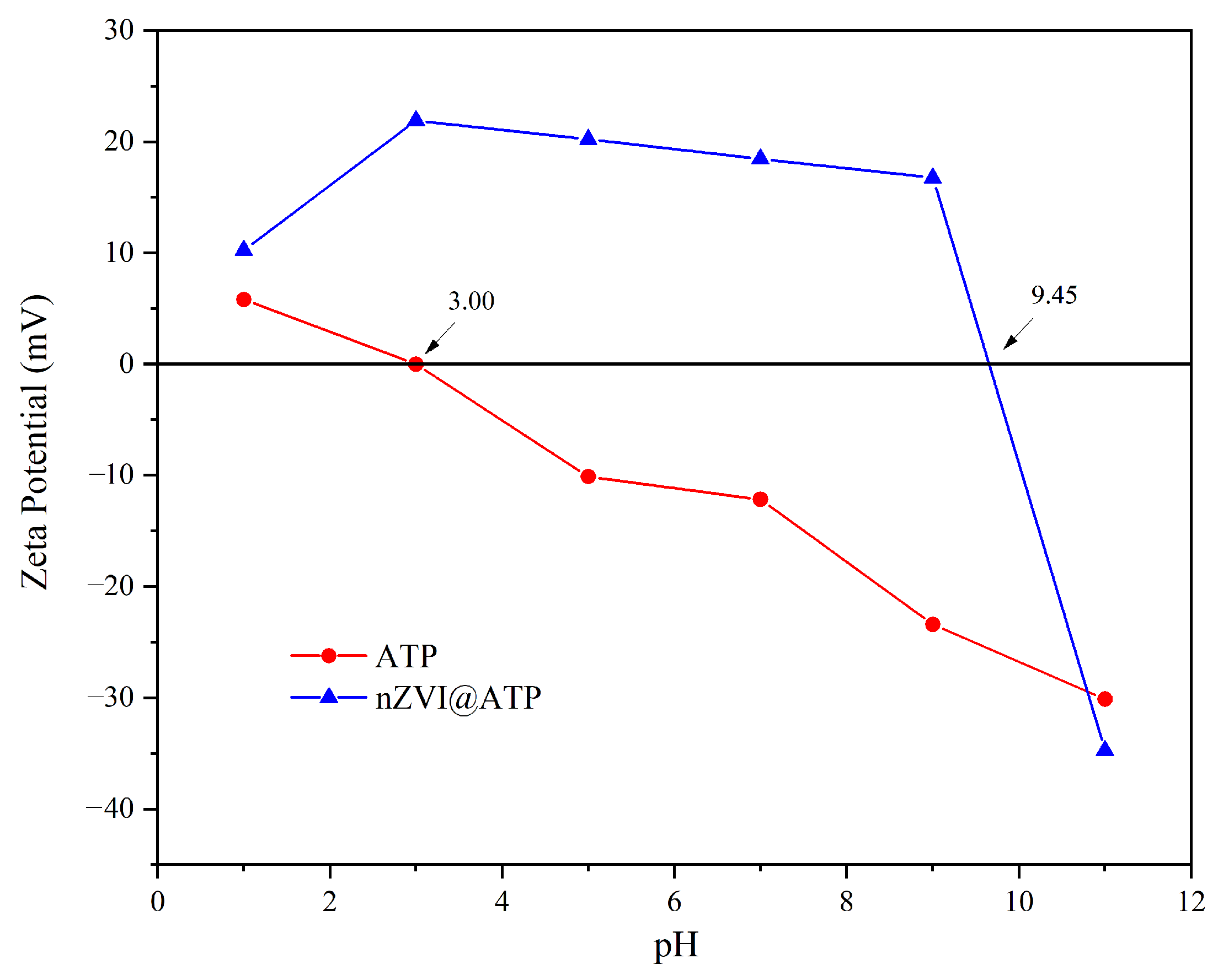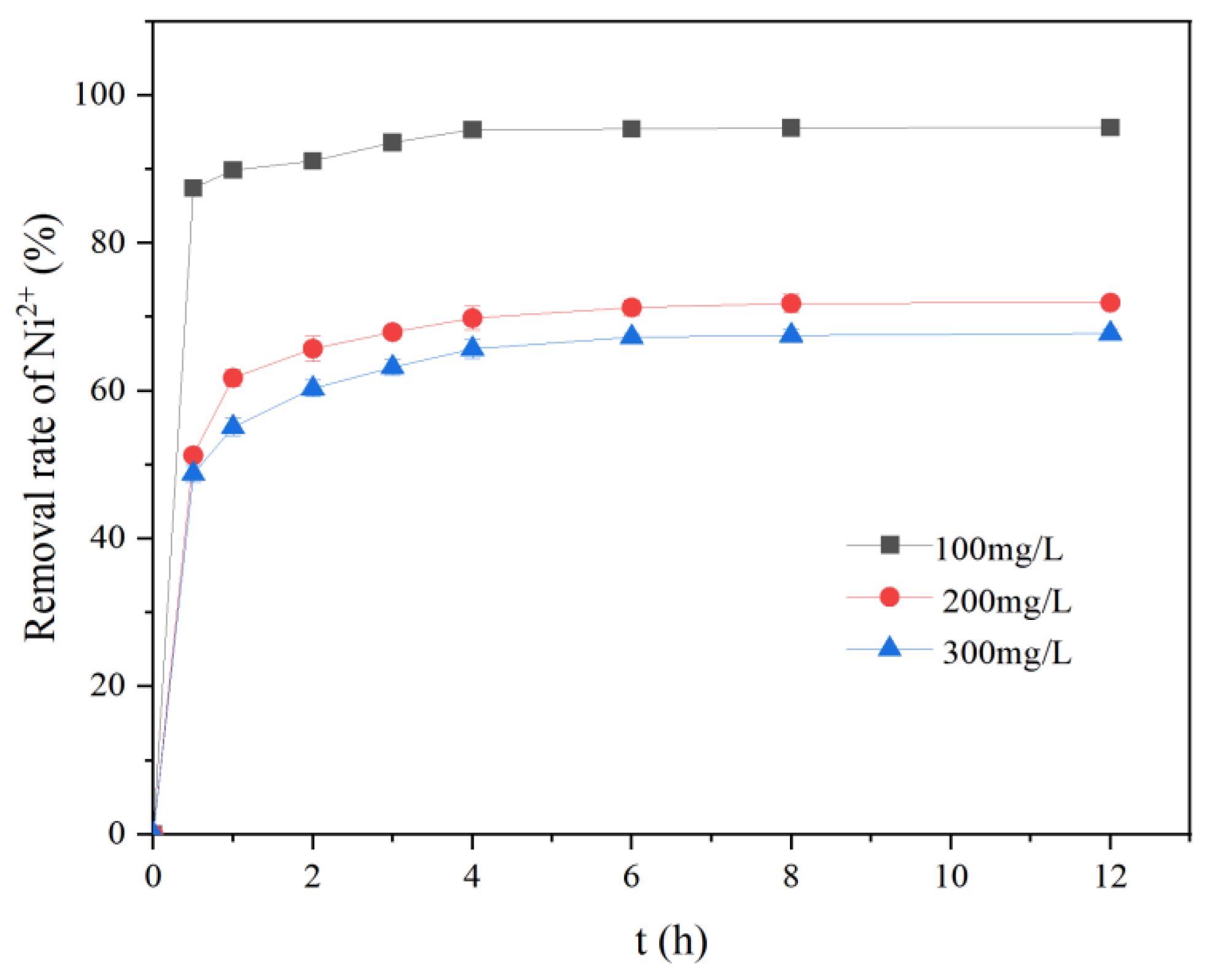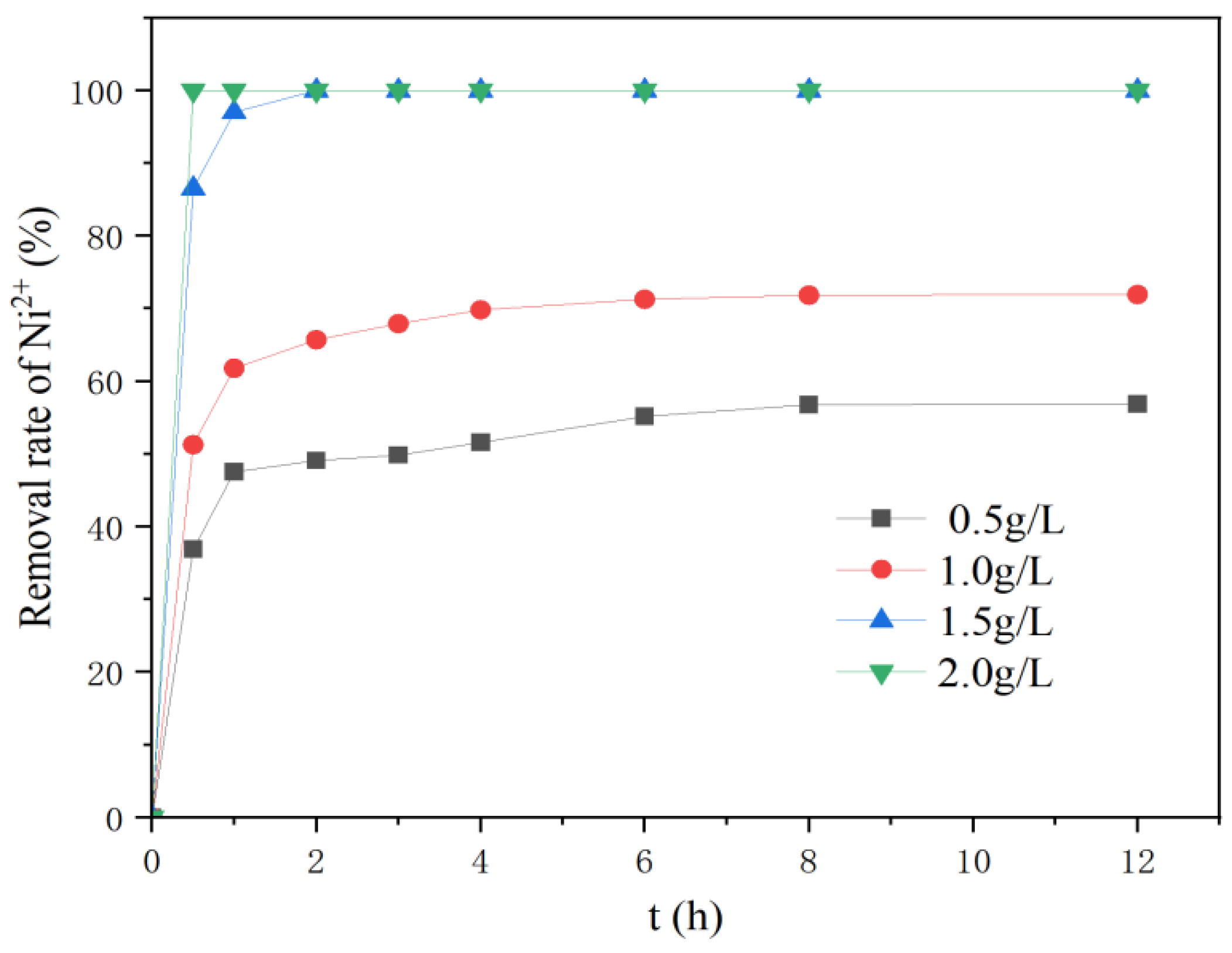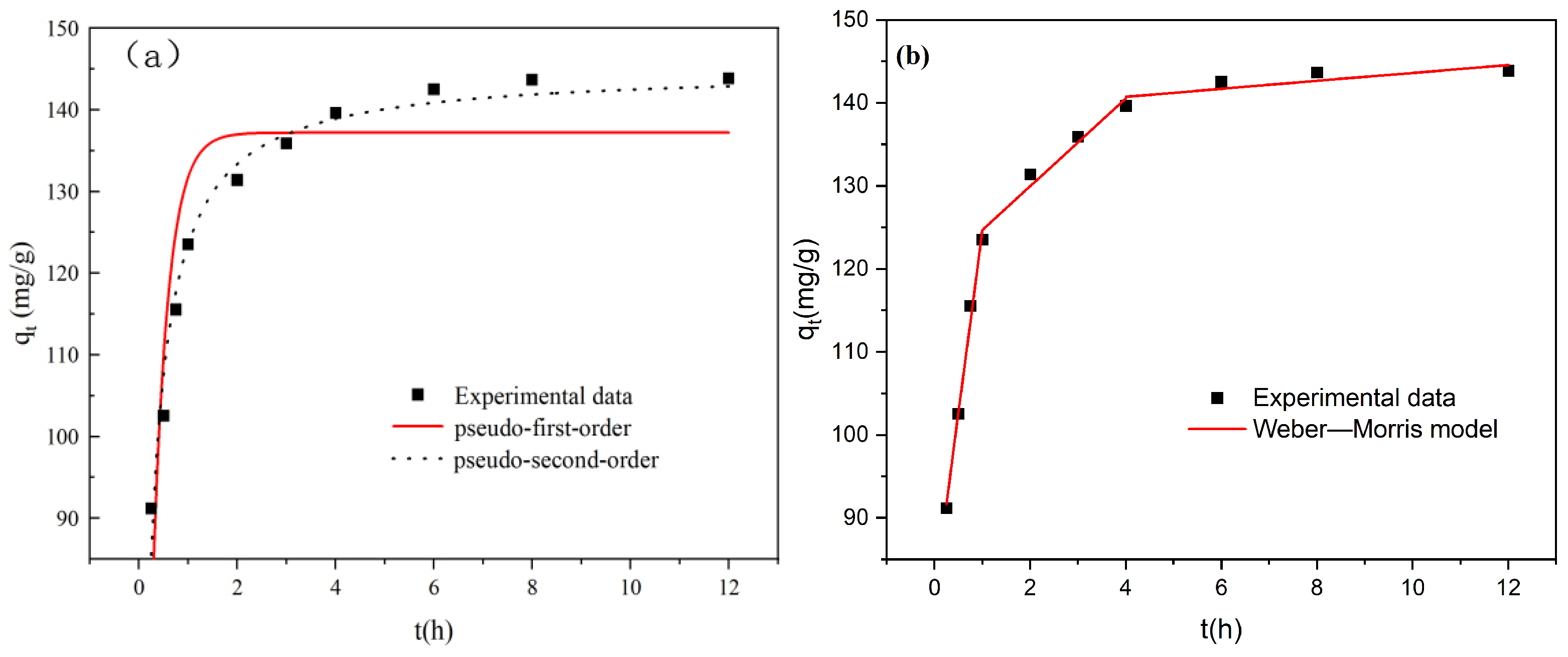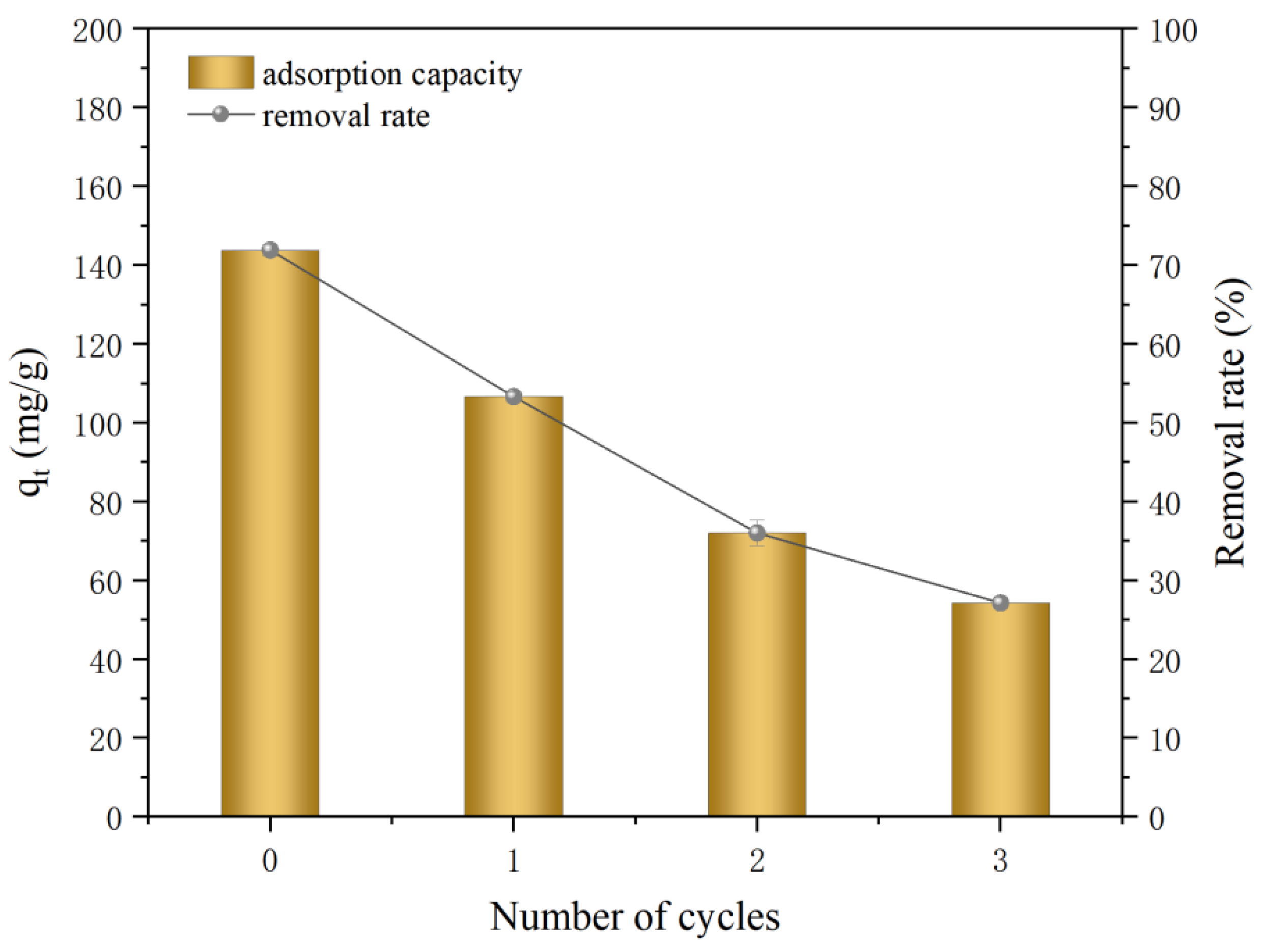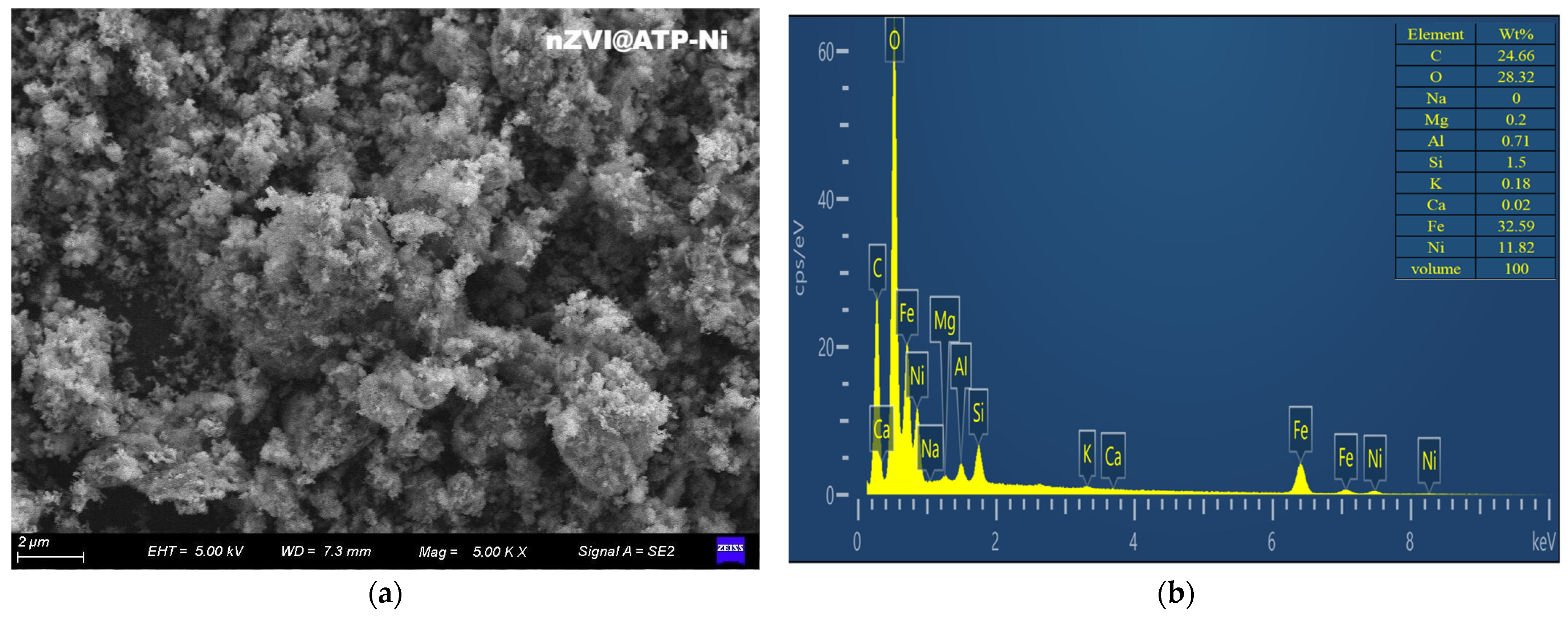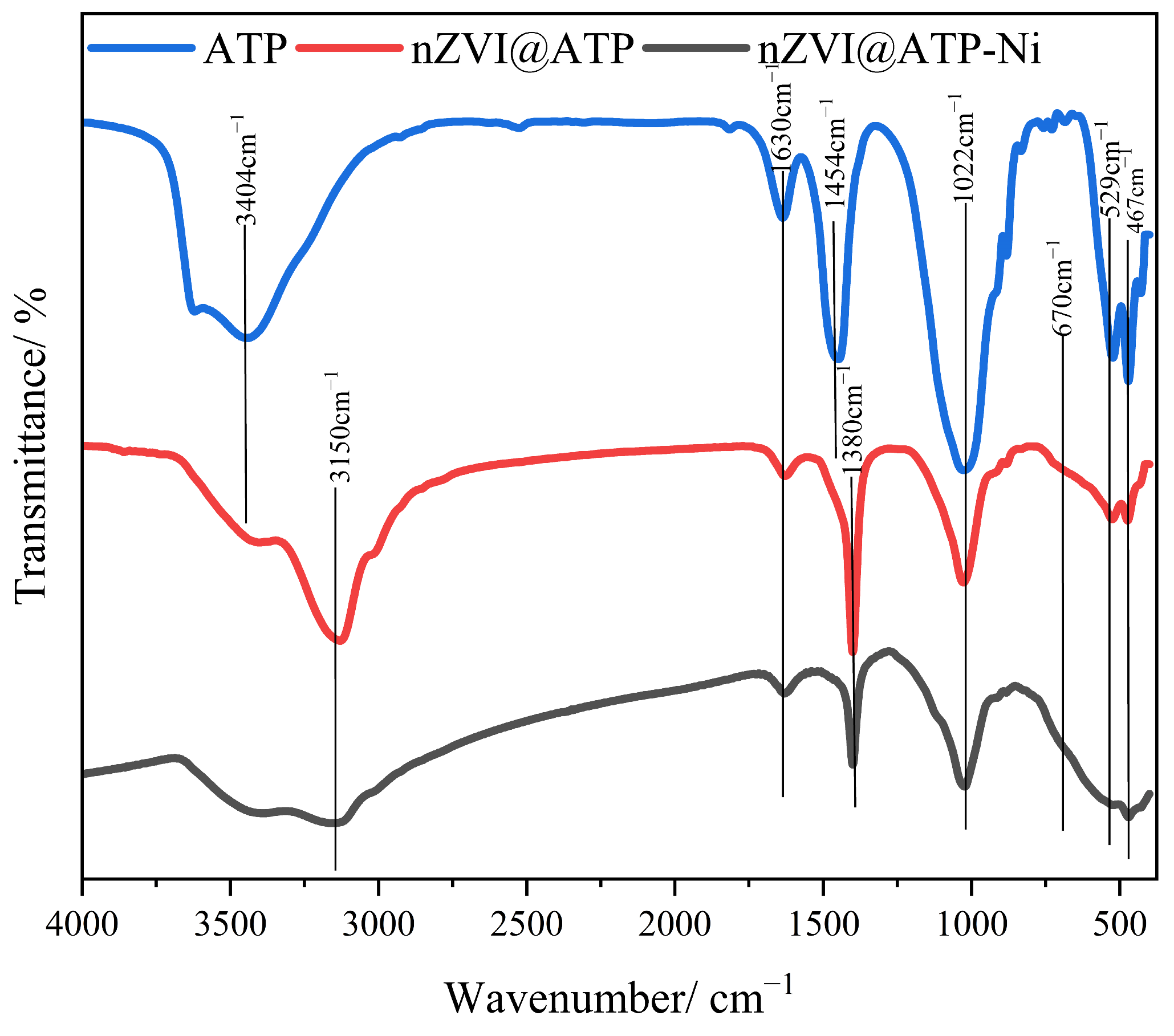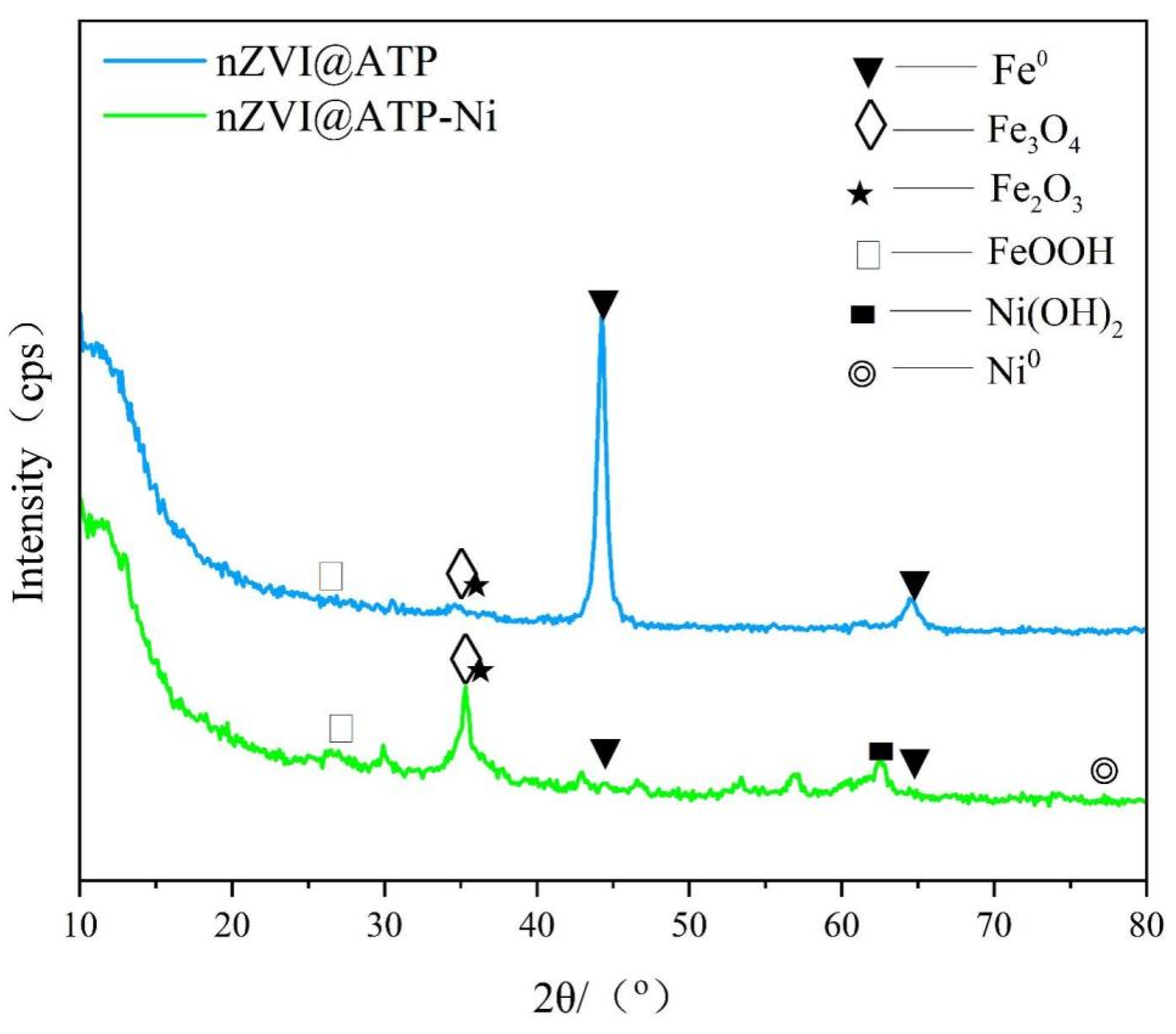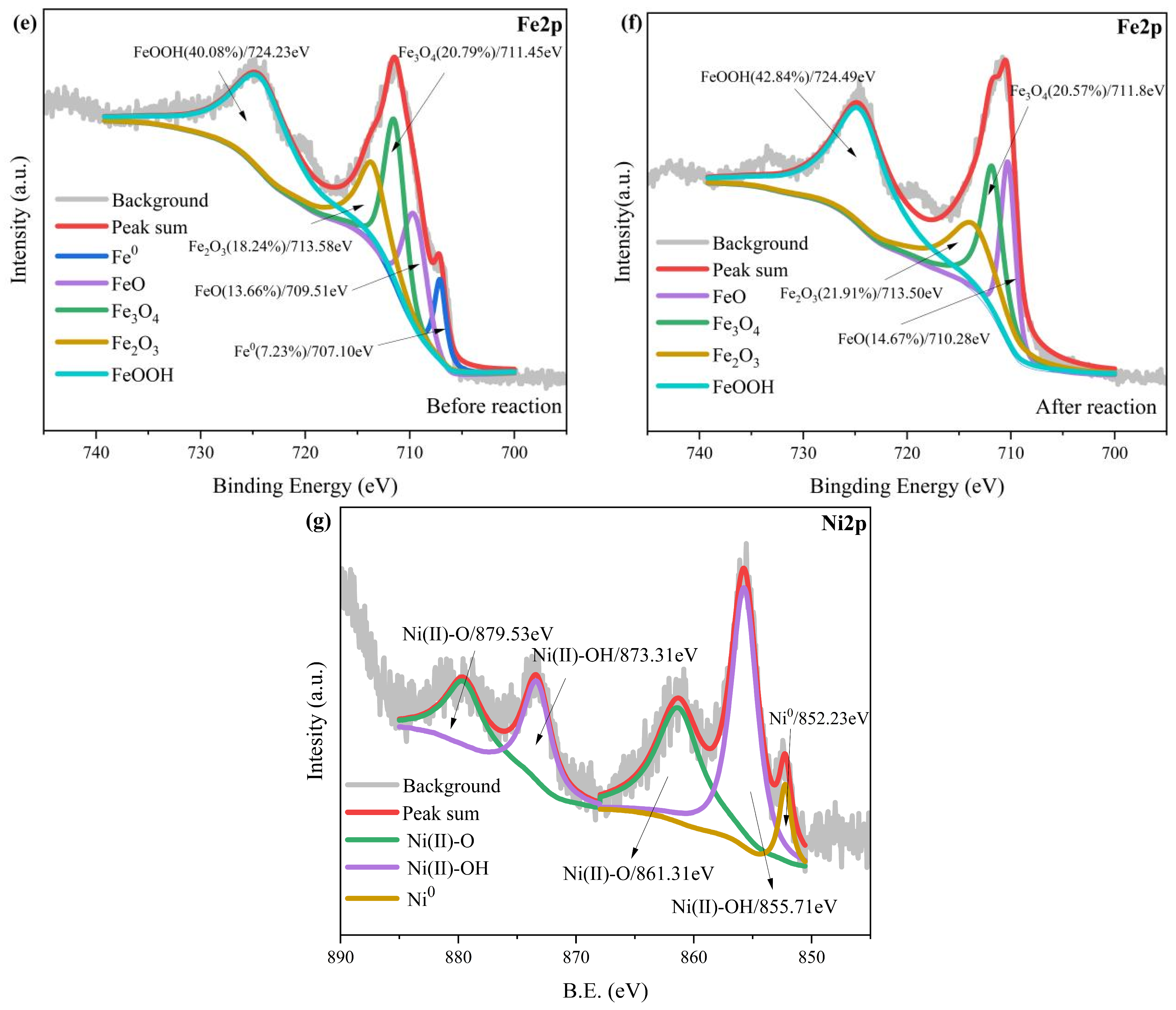1. Introduction
Despite the rapid advancement of industrial development and its associated positive aspects, including technological advancements, economic growth, and job opportunities, it has concurrently led to increasingly severe environmental problems, which arise from the discharge of numerous amounts of heavy metal elements into water bodies through electroplating, mining, metallurgy, and other activities [
1]. In addition, the impact of human activities, such as agricultural production and domestic waste discharge, further contributes to the abovementioned issues, particularly concerning natural water bodies [
2]. Over the past 50 years, the average concentrations of heavy metals (Cd, Pb, Cr, Ni, Al, and Mn) detected in surface freshwater around the world, specifically in Africa, Asia, Europe, and South America, have consistently exceeded the safety limits set by the WHO and US EPA [
3,
4,
5]. In the industrial zone of Meghna Ghat in Bangladesh, samples have shown excessive levels of Cr, Cd, Ni, and Pb [
6]. Similarly, in Nigeria, Cd, Cr, Mn, Ni, and Pb concentrations in surface freshwater have exceeded the maximum recommended levels for drinking water set by WHO [
7]. Therefore, addressing the problem of heavy metal pollution, particularly removing heavy metal ions from water bodies, is a major global concern [
8]. Ni and its compounds have many industrial and commercial uses. Given their widespread use in aircraft, electroplating, steel, and metallurgical industries, excessive Ni content is released into the environment. The Ni
2+ concentrations in terrestrial and aquatic resources can reach 26 g/kg and 0.2 mg/L, respectively, which is about 25 times that of uncontaminated resources [
9]. Ni has become one of the major pollutants in the ecological environment. Ni
2+ has detrimental effects on the environment, human body, and microorganisms, and animal experimentations have confirmed the carcinogenicity of Ni compounds as they can induce tumor production and disrupt the human immune system, causing allergic reactions [
10,
11].
Currently, compared to the inefficiency of chemical precipitation techniques and the interference susceptibility of ion exchange technologies in the treatment of heavy metal-polluted wastewater, as well as the high cost associated with electrochemical techniques, adsorption presents significant advantages in practicality, cost-effectiveness, and efficiency, making it an effective method for treating Ni. Adsorption is considered to be an efficient, convenient, and economical method for wastewater treatment. The flexibility in design and operation, the high removal efficiency, and the possibility of regeneration and reuse of most adsorbents through appropriate desorption processes contribute to the increasing popularity of adsorption processes. It relies on the interaction between porous solid adsorbents and heavy metal ions, with the main mechanisms including electrostatic adsorption, composite adsorption, ion exchange, etc. [
12,
13,
14]. This process promotes the enrichment of heavy metal ions on the adsorbent, ultimately achieving the purpose of purifying the water body [
15]. Recently, clay minerals have been widely used as adsorbents for removing heavy metal ions from water [
16]. Attapulgite (ATP), whose theoretical chemical formula is Mg
5·Si
8·O
20(OH)
2(OH
2)
4·4H
2O, is a 2:1 layered chain hydrated magnesium-rich silicate clay mineral with a specific rod-like crystal structure, considerable surface area, and unique surface charge distribution characteristics [
17]. Owing to its rich mineral resources, easy access, low cost, nontoxic nature, and multiple applications, natural ATP has excellent potential for solving heavy metal pollution in water [
18,
19]. The ATP clay resources in Linze, Gansu are relatively abundant, with ATP from the Linze mine exhibiting a stratified distribution and a brick-red surface [
20]. However, the low-grade ATP from the original mine contains many impurities and has a rough surface and a low specific surface area, resulting in substantially weakened physicochemical properties, hampering its large-scale exploitation.
Owing to its large specific surface area and strong reactivity, nanoscale zero-valent iron (nZVI) is widely used for remediating water and soil pollution [
21]. The nZVI reduction technology offers several advantages, including a rapid reaction, a simple process, suitability for small-scale and decentralized treatments, and an absence of the drawbacks associated with traditional methods. In addition, nZVI is an active, inexpensive, widely available, and environmentally friendly substance, making it a popular choice for remediating heavy metal pollution [
22]. However, owing to its propensity for easy agglomeration and oxidation, which reduces its overall performance, nZVI cannot be used alone for pollutant removal [
23]. Furthermore, ATP can be used as an excellent solid phase negative carrier owing to its good dispersion ability and mechanical properties [
20]. Accordingly, nZVI loading onto ATP to prepare nZVI@ATP—a new pollutant remover—can substantially improve nZVI dispersion and increase the contact area of nZVI with pollutants [
24], affording a new and efficient composite material for removing Ni-induced pollution in water.
This study explores the Ni2+ removal performance and mechanism of nZVI@ATP in water. A liquid-phase reduction method was used to synthesize nZVI@ATP composites with different iron-to-soil ratios, after which static adsorption of Ni2+ was conducted to investigate the effects of the initial concentration, dosing amount, initial pH, and coexisting ions on the adsorption capacity of nZVI@ATP composites. The kinetic and intraparticle diffusion models were used to investigate the nZVI@ATP adsorption properties of Ni2+ in water. Furthermore, scanning electron microscopy–energy dispersive spectroscopy (SEM–EDS), Fourier transform infrared (FTIR) spectroscopy, X-ray diffraction (XRD), X-ray photoelectron spectroscopy (XPS), and other characterization methods were used in combination to uncover the mechanism of Ni2+ adsorption by nZVI@ATP.
2. Materials and Methods
2.1. Materials
Ferrous sulfate heptahydrate (FeSO4·7H2O, ≥99.0%), anhydrous ethanol (C2H5OH, ≥99.7%), sodium borohydride (NaBH4, ≥98.0%), sodium hydroxide (NaOH, ≥96.0%), nitric acid (HNO3), hydrochloric acid (HCl), and nickel chloride hexahydrate (NiCl2·6H2O, ≥99%) were purchased from the National Chemical Reagent Company. Furthermore, sodium nitrate (NaNO3, ≥99.0%) was purchased from Tianjin Damao Chemical Reagent Factory. All chemical reagents were of an analytical grade. ATP was purchased from Gansu Hanxing Environmental Protection Technology Co., Ltd. (Lanzhou, China). The mineral composition of the ATP was as follows: 19.3% ATP, 15.1% quartz, 5.3% seafoam, 19.8% feldspar, 10.9% muscovite, and 6.9% mica, while the remaining 22.7% comprised a combination of chlorite, kaolinite, gypsum, montmorillonite, and calcite. The pH value of the ATP was 8.47.
2.2. Preparation of nZVI@ATP and nZVI
ATP (200-mesh sieved) and FeSO
4·7H
2O were dissolved in a three-necked flask with 100 mL of deionized water at different mass ratios of iron to ATP (3:1, 2:1, 1:1, 1:2, and 1:3) and stirred for 2 h, followed by the addition of 100 mL of anhydrous ethanol and a 30 min stirring. Subsequently, 400 mL of a 0.5-mol/L NaBH
4 solution was immediately added at a rate of 1–2 drops/s, and nZVI@ATP was obtained after centrifugation. Further, the nZVI@ATP was washed thrice with ethanol and deionized water and dried under vacuum at 40 °C for 6 h. This procedure was conducted in a N
2 atmosphere, and the nZVI@ATP was stored under a vacuum seal in a refrigerator freezer layer for backup. The preparation process of the nZVI was the same as the process mentioned above, with the only difference being the absence of ATP. The reaction equation is shown in Equation (1).
2.3. Adsorption of Ni2+ by nZVI@ATP
2.3.1. Screening of nZVI@ATP Adsorbents with Different Ratios of Fe and ATP
ATP, nZVI, and nZVI@ATP samples with different iron-to-ATP ratios were added to centrifuge tubes loaded with 30 mL of 200 mg/L Ni2+ solution at 1 g/L. The solution pH was adjusted to 5.0 using 0.1-mol/L HCl and 0.1-mol/L NaOH before adding the Ni2+ solution. The resulting solution was placed in a constant temperature water bath, shaken at 298 K and 220 r/min for 12 h, and passed through a 0.45 μm filter membrane. The Ni2+ residual concentration after the aforementioned reaction was detected using a flame atomic absorption spectrophotometer (FAAS) to determine the composite with the best adsorption performance for Ni2+. Subsequent experiments were conducted based on the determination of the optimal iron-to-ATP ratio in combination with the actual situation.
2.3.2. Effect of Initial Concentration on Ni2+ Adsorption by nZVI@ATP
After adding nZVI@ATP at an injection rate of 1 g/L, 30 mL of Ni2+ solutions with initial concentrations of 100, 200, and 300 mg/L were added to the centrifuge tubes, and the pH was adjusted to 5. The solutions were then shaken for 0.5, 1, 2, 3, 4, 6, 8, and 12 h at 25 °C in a constant temperature water bath and removed and filtered through a 0.45 µm microporous filter membrane. Subsequently, the remaining Ni2+ concentration in the solution was measured.
2.3.3. Effect of Dosing Amount of Solution on Ni2+ Adsorption by nZVI@ATP
After adding nZVI@ATP at concentrations of 0.5, 1.0, 1.5, and 2.0 g/L, 30 mL of the 200 mg/L Ni2+ solution with a pH of 5 was added, shaken in a constant temperature water bath at 25 °C, removed, and filtered through a 0.45 µm microporous membrane. Thereafter, the concentration of the remaining Ni2+ in the solution was measured.
2.3.4. Effect of pH on Ni2+ Adsorption by nZVI@ATP
The initial pH of the Ni2+ solution (200 mg/L) was pre-adjusted to 2, 3, 4, 5, 6, and 7. The nZVI@ATP adsorbent was added to different pH solutions at 1 g/L dosing to examine the effect of the pH. The solution was shaken in a shaker at 25 °C for 12 h at 200 r/min and then passed through a 0.45 µm filter membrane to measure the concentration of the remaining Ni2+ in the solution.
2.3.5. Adsorption Kinetics Experiment
The kinetics of the Ni2+ removal by nZVI@ATP were investigated. In total, 30 mL of Ni2+ solution was added at an initial concentration of 200 mg/L to the centrifuge tube, and the pH was adjusted to 5. The nZVI@ATP was added to the centrifuge tube at a dosage of 1 g/L, and the solutions were then shaken for 0.25, 0.5, 0.75, 1, 2, 3, 4, 6, 8, and 12 h at 25 °C in a constant temperature water bath, removed, and filtered through a 0.45 µm microporous filter membrane. Subsequently, the remaining Ni2+ concentration in the solution was measured.
2.3.6. Material Recycling Experiments
The reacted nZVI@ATP material was rinsed repeatedly with 0.5 mol/L of dilute nitric acid, centrifuged, and filtered. The treated material was placed in a vacuum drying oven, stored in a heated vacuum for 12 h, and then removed, ground, and sieved. Subsequently, it was added to a 30 mL Ni2+ solution with a concentration of 200 mg/L at a dose of 1 g/L of nZVI@ATP. The resulting solution was placed in a constant temperature water bath shaker and shaken at 25 °C. The solution was then placed in a thermostatic water bath shaker and shaken at 25 °C and 220 rpm for 12 h; after which, it was removed. The remaining Ni2+ concentration was measured for three consecutive cycles using the aforementioned method.
2.4. Characterization
The morphology and elemental composition of the adsorbents were analyzed via SEM (GeminiSEM500, Carl Zeiss AG, Jena, Germany) and EDS (X-max ExtremeX, Oxford Instruments, Abingdon, UK). The specific surface area and pore size of the adsorbents were determined based on the Barrett Joyner Halenda (BJH) adsorption model and the t-plot micropore model using a specific surface area and porosity analyzer (BET, ASAP2020, Micromeritics Instruments, Norcross, GA, USA). XRD (Rigaku, Rigaku Corporation, Tokyo, Japan) was used to analyze the crystal structure and material composition of the adsorbents in the 2θ range of 2–80° using CuKα radiation. The functional groups of nZVI@ATP were analyzed at 4000–400 cm−1 via FTIR spectroscopy (Vertex70; Bruker, Ettlingen, Germany; 1 mg sample and 110 mg of KBr). The zeta potential of the samples was determined using a zeta potential tester (Nano-ZS90, Malvern Panalytical, Malvern, UK). XPS (Kratos AXIS Ultra DLD, Kratos, Manchester, UK) was performed to analyze the valence states of the major elements in the adsorbents after calibration based on the C1s peaks. The Ni2+ concentration in aqueous solutions was determined via FAAS (220FS, Varian, Palo Alto, CA, USA).
2.5. Data Processing Methods
Three parallel samples were used for the abovementioned experiments; the results were averaged, and the standard deviations were calculated using Excel. The experimental data were processed and plotted using Origin 2019b. The adsorption amount (
qe, mg/g) and removal rate (
R, %) were calculated as follows:
where
qe is the sorption amount, mg/g;
C0 denotes the initial concentration of the pollutant, mg/L;
Ce denotes the remaining concentration of the pollutant, mg/L;
V is the volume of the pollutant solution, L; and
m is the material dosing amount, g.
The equations for the pseudo-first-order, pseudo-second-order, and Weber–Morris models are as follows [
24,
25,
26,
27,
28]:
where
qt denotes the amount of pollutants adsorbed by nZVI@ATP at moment
t, mg/g; k
1 is the quasi-primary kinetic equation rate constant, g/(mg·h); k
2 is the quasi-secondary kinetic equation rate constant, g/(mg·h); k
d is the rate constant of the intraparticle diffusion equation, mg/(g·h
1/2); and E
i denotes the intercept, mmol/g.
